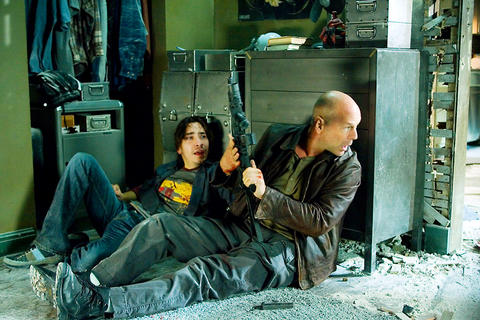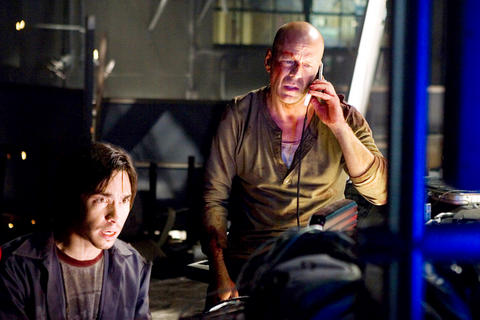The gasping, grunting and oozing hard-body slab that muscles, and sometimes crawls, through Live Free or Die Hard (released in Taiwan as Die Hard 4.0) sure looks like John McClane. Older if apparently no wiser, the blue-collar super-cop from the Die Hard franchise has lost his hair, his foul mouth and apparently his nicotine itch, but he still has the same knack for trouble, the adrenaline-pumping, cheerfully anarchic kind that causes cars to ignite, bodies to fly, eardrums to pop and hearts to race and gladden. He's also lost his sneer, but sneering is cheap, and movies are expensive, especially when your star has pushed past 50 and slid off the power lists.
A lot has happened in the 12 years since Bruce Willis yippee-kai-yay-ed in Die Hard With a Vengeance with a glowering Samuel L. Jackson in tow. During that time Willis' star has expanded and collapsed through hits and duds and plenty of personal off-screen noise. The world has changed too, of course, and with it the action-flick coordinates: for one, Arnold Schwarzenegger runs California, while the sober, nonwisecracking likes of Matt Damon's Bourne rules the bad-boy roost. For another: Willis has become an increasingly appealing character actor, the kind who punches up a scene or two (Alpha Dog, Fast Food Nation) or an entire movie (16 Blocks), mostly by playing it not so nice and very easy.
Life or age or something has mellowed Willis. He no longer enters a movie like God's gift, as he did almost two decades ago in the first Die Hard, lips pursed as if he alone were in on the joke - which, given the fat salary he was earning, perhaps he was. In Live Free or Die Hard he enters swinging, fist smashing through hard glass and sinking into soft flesh. He's making a point and so is the movie, namely that McClane (and Willis) is ready to earn our love again by performing the same lovably violent, meathead tricks as before. And look, he's not laughing, not exactly, even if the film ends up a goof.

PHOTOS: COURTESY OF FOX
An unexpectedly funny goof, at that, despite everything, including the mayhem and somewhat creepy plot. The screenplay attributed to Mark Bomback, who shares the story credit with David Marconi, has the whiff of multiple writers, as action-driven productions generally do. It originated with a 1997 story (dubiously titled A Farewell to Arms) by John Carlin in Wired magazine about the potential for a cataclysmic, nation-crippling "information war," which mutated and stalled, picking up new writers and equally doubtful names (WW3.com, Die Hard 4.0). Somewhere along the development line, the real world intruded, which is why the original idea about an information war now includes a plausible-sounding or at least not entirely outlandish hook to Sept. 11 - hence, the creepiness.
In most Hollywood action movies, references to Sept. 11 as well as to the wars in Iraq and Afghanistan are often tacked on or displaced, used for decorative flag-waving or scenes of torture. Live Free or Die Hard tries to engage the real world more directly than most studio-made fantasies, with a logic-defying plot involving a disgruntled government security expert. That would be Thomas Gabriel, who seems partly inspired by the counterterrorism expert Richard Clarke and partly informed by Bill Gates and is wholly played by the pretty Timothy Olyphant, dressed in black and wearing Maggie Q on his arm. Olyphant has many charms, but annihilating menace is not one of them. Willis nonetheless keeps any incredulity in check along with his sneer.
Despite its jaw-jutting title, with its evocation of revolutionary America and radical individualism, Live Free or Die Hard keeps a tighter rein on McClane, dialing down his man-against-the-world attitude to a low hum. He's still more or less alone, at least existentially, though, as per the action playbook, he quickly picks up a sidekick and audience surrogate in the hacker impersonated by Justin Long (flicking between annoyance and amusement).

But McClane is also unequivocally playing for team America, helping the FBI and its no-nonsense, supremely capable deputy director, Bowman (Cliff Curtis), who runs the sillily named cyber division with blinking monitors and scurrying minions. Heroic in deed and in acquaintance, Bowman knows to side with McClane, saving his contemptuous looks for the guy from Homeland Security.
Nothing on Len Wiseman's resume - he previously directed the two Underworld flicks, wherein the Goth kids really are vampires - suggests that he could wrangle both Willis and this new film's nerve-jangling action to such satisfying effect. At least on the second count he has received terrific help from a sprawling cast of stuntmen and women (and the stunt coordinator Brad Martin), who do a great deal to advance the film's old-school mayhem. The use of Parkour during several fight scenes is particularly tasty, proving that when cinematic push comes to shove, the French, who originated this ultra-cool rough-and-tumble, which finds performers bouncing like balls from wall to wall, rooftop to rooftop and many hair-raising points in between, are definitely in the coalition of the willing.

June 9 to June 15 A photo of two men riding trendy high-wheel Penny-Farthing bicycles past a Qing Dynasty gate aptly captures the essence of Taipei in 1897 — a newly colonized city on the cusp of great change. The Japanese began making significant modifications to the cityscape in 1899, tearing down Qing-era structures, widening boulevards and installing Western-style infrastructure and buildings. The photographer, Minosuke Imamura, only spent a year in Taiwan as a cartographer for the governor-general’s office, but he left behind a treasure trove of 130 images showing life at the onset of Japanese rule, spanning July 1897 to

One of the most important gripes that Taiwanese have about the Democratic Progressive Party (DPP) is that it has failed to deliver concretely on higher wages, housing prices and other bread-and-butter issues. The parallel complaint is that the DPP cares only about glamor issues, such as removing markers of Chinese Nationalist Party (KMT) colonialism by renaming them, or what the KMT codes as “de-Sinification.” Once again, as a critical election looms, the DPP is presenting evidence for that charge. The KMT was quick to jump on the recent proposal of the Ministry of the Interior (MOI) to rename roads that symbolize

On the evening of June 1, Control Yuan Secretary-General Lee Chun-yi (李俊俋) apologized and resigned in disgrace. His crime was instructing his driver to use a Control Yuan vehicle to transport his dog to a pet grooming salon. The Control Yuan is the government branch that investigates, audits and impeaches government officials for, among other things, misuse of government funds, so his misuse of a government vehicle was highly inappropriate. If this story were told to anyone living in the golden era of swaggering gangsters, flashy nouveau riche businessmen, and corrupt “black gold” politics of the 1980s and 1990s, they would have laughed.

Imagine being able to visit a museum and examine up close thousand-year-old pottery, revel alone in jewelry from centuries past, or peer inside a Versace bag. Now London’s V&A has launched a revolutionary new exhibition space, where visitors can choose from some 250,000 objects, order something they want to spend time looking at and have it delivered to a room for a private viewing. Most museums have thousands of precious and historic items hidden away in their stores, which the public never gets to see or enjoy. But the V&A Storehouse, which opened on May 31 in a converted warehouse, has come up